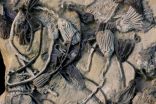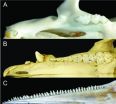(Press-News.org) LEXINGTON, Ky. (Feb. 18, 2013) — A study by a leading Alzheimer's researcher at the University of Kentucky provides new evidence that will help researchers home in on the molecular mechanisms involved in inflammation of the central nervous system (CNS) and aid drug-development strategies for treating inflammatory neurological diseases.
The research was led by Linda Van Eldik, director of UK's Sanders-Brown Center on Aging, and included co-authors Bin Xing and Adam Bachstetter from the Van Eldik lab. The study demonstrated that the beta isoform of p38 mitogen-activated protein kinase (MAPK) has no apparent effect on inflammatory cytokine response and neurotoxicity in brain-cell cultures or in the brains of living mice.
Others have reported that the p38beta isoform is not involved in peripheral inflammatory disorders, such as arthritis and inflammatory bowel disease. However, whether p38beta is important in brain inflammation had not been studied before.
Taken together with previous studies by Van Eldik's lab, which document the critical role of p38alpha in CNS proinflammatory cytokine production and neuron survival, the new study further supports the idea that p38alpha, and not p38beta, is the key p38 isoform involved in central inflammatory responses.
The new findings also suggest that development of p38-inhibitor drugs to target CNS inflammatory diseases may not need to consider retention of p38beta inhibitory activity, but should instead focus on selectively targeting the p38alpha MAPK isoform as a potential therapeutic strategy.
The study used mice where the p38beta kinase was specifically eliminated, and asked whether brain cells that did not have p38beta could generate an inflammatory cytokine response and induce subsequent neuron death after treatment with a standard inflammatory stimulus.
The research found that in brain-cell cultures, and in mice treated with the inflammatory stimulus, the inflammatory cytokine response and neurotoxicity were the same whether the mice had normal p38beta levels or were deficient in p38beta. These results showed that, in agreement with peripheral inflammation models, p38beta is also expendable in the brain in terms of regulation of proinflammatory cytokines and downstream neurotoxicity.
###
Van Eldik's paper, "Deficiency in p38beta MAPK Fails to Inhibit Cytokine Production or Protect Neurons against Inflammatory Insult in In Vitro and In Vivo Mouse Models," appeared online Feb. 15 in PLOS One, a peer-reviewed, open-access journal published by Public Library of Science.
MEDIA CONTACT: Keith Hautala, (859) 323-2396; keith.hautala@uky.edu
Study: p38beta MAPK not critical to brain inflammation
2013-02-19
ELSE PRESS RELEASES FROM THIS DATE:
Variations within influenza strain may explain varying patient response
2013-02-19
LOUISVILLE, Ky. – Just the mention of H1N1 can conjure up images of long lines of people waiting to be vaccinated, news reports of the severity of the pandemic and the count of the number of people who perished from the 2009-10 outbreak. However, some positives are coming forward.
Researchers at the University of Louisville have found variations within H1N1 patients who were hospitalized and identified those that most impacted patients. Their findings were published today (Feb. 18, 2013) on the PLOS ONE website.
"While all of the variants that we uncovered hijacked ...
Johns Hopkins Medicine and Fundación Santa Fe de Bogotá collaboration to focus on research, nursing
2013-02-19
An expansion of collaborative projects involving Fundación Santa Fe de Bogotá (FSFB), one of Colombia's premier health care institutions, and Johns Hopkins Medicine International (JHI) will continue for another 10 years under an agreement signed Feb. 18, 2013, in Baltimore, USA. The collaboration agreement detailing joint efforts in research and nursing, among other areas, was signed by Steven J. Thompson, chief executive officer of JHI, and Juan Pablo Uribe, chief executive officer of FSFB.
"It is a privilege to have the opportunity to strengthen our collaboration with ...
Ancient fossilized sea creatures yield oldest biomolecules isolated directly from a fossil
2013-02-19
COLUMBUS, Ohio—Though scientists have long believed that complex organic molecules couldn't survive fossilization, some 350-million-year-old remains of aquatic sea creatures uncovered in Ohio, Indiana, and Iowa have challenged that assumption.
The spindly animals with feathery arms—called crinoids, but better known today by the plant-like name "sea lily"—appear to have been buried alive in storms during the Carboniferous Period, when North America was covered with vast inland seas. Buried quickly and isolated from the water above by layers of fine-grained sediment, their ...
It's off to work we go
2013-02-19
This press release is available in French.
Montreal, February 18, 2013 – In a large city like Montreal, public transit provides us with options for getting to work or school and back home again. In deciding to choose traffic jams over metro delays, or to pay for parking rather than buy a monthly pass, you weigh the pros, cons and costs of your options, and your mental calculations are more complicated than they may appear at first glance.
In a paper recently published in The Journal of Transportation and Land Use, Zachary Patterson, an assistant professor in Concordia ...
Solar sponge' soaks up CO₂ emissions
2013-02-19
CSIRO scientists have created a 'solar sponge' which captures and then releases carbon dioxide using the power of natural sunlight.
The breakthrough presents a new way to recycle CO2 emissions using renewable energy. The 'sponge' which is made from a new smart material called a MOF - metal organic framework - adsorbs carbon dioxide, but when exposed to sunlight, instantaneously releases it.
Known as dynamic photo-switching, this capture-and-release method is extremely energy efficient and only requires UV light to trigger the release of CO2 after it has been captured ...
New evidence for link between depression and heart disease
2013-02-19
MAYWOOD, Il. - A Loyola University Medical Center psychiatrist is proposing a new subspecialty to diagnose and treat patients who suffer both depression and heart disease. He's calling it "Psychocardiology."
In his most recent study, Angelos Halaris, MD, PhD, and colleagues found that an inflammatory biomarker, interleukin-6, was significantly higher in the blood of 48 patients diagnosed with major depression than it was in 20 healthy controls. Interleukin-6 has been associated with cardiovascular disease. Halaris presented findings at a joint congress of the World Psychiatric ...
In fight against cancer, a closer look at nuclear blebbing
2013-02-19
Misshapen cell nuclei are frequently observed in the cells of people with cancer and other diseases, but what causes the abnormality -- and why it is associated with certain disorders -- has remained unclear.
Researchers at Northwestern University have recently developed a mathematical model that sheds light on the defect by clarifying the mechanisms that cause bulges known as "blebs" in cells' nuclear membranes. The research -- a collaboration between experts at the McCormick School of Engineering and Applied Science and the Feinberg School of Medicine -- could be a ...
Nesting site protection 'key to save turtles from climate change'
2013-02-19
International marine scientists today warned it will be vital to protect key marine turtle nesting grounds and areas that may be suitable for turtle nesting in the future to ensure that the marine reptiles have a better chance of withstanding climate change.
A new study reveals that some turtle populations in the West Indian Ocean, Northeast Indian Ocean, North Pacific Ocean, East Atlantic Ocean and the East Pacific Ocean are among the least likely to recover from the impacts of climate change. Mariana_19feb_2
"To give marine turtles a better chance of coping with climate ...
5-ALA fluorescence guides resection of recurrent glioblastoma multiforme
2013-02-19
Charlottesville, VA, February 19, 2013. Neurosurgeons from UC San Francisco describe the use of 5-aminolevulinic acid (5-ALA) fluorescence in guiding resection of recurrent glioblastoma multiforme (GBM). Ingestion of 5-ALA by a patient before surgery leads to fluorescence of tumor cells intraoperatively in response to certain wavelengths of light. This can provide information not necessarily available through magnetic resonance imaging (MRI), the standard mode of imaging used to detect primary and recurrent GBMs. The additional information provided by 5-ALA fluorescence ...
How the whale got its teeth
2013-02-19
Whales are mammals, but they don't look like the mammals living around us, as they have a triangular fluke for tail, no hind legs and no body hair. And inside their mouths, their teeth are unfamiliar too – being much simpler and 'peg like'. A multidisciplinary team of researchers have now married together the fossil record and the embryonic development process to investigate how the whale got its teeth.
Most mammals have four kinds of teeth, each shaped for specific tasks. In most mammals there are wedge-shaped incisors, a pointy canine, and premolars and molars with ...

